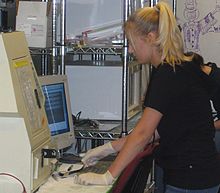Agronomy
 |
| Agriculture |
|---|
History |
|
On land |
|
In water |
|
Related |
|
Lists |
|
Categories |
|
 An agronomist measures and records corn growth and other processes. | |
| Occupation | |
|---|---|
| Names | agronomist agricultural scientist crop scientist |
Occupation type | profession |
Activity sectors | agriculture, agronomy |
| Description | |
| Competencies | technical knowledge, sense of analysis |
Fields of employment | food industry, science, research and development |
Related jobs | see related disciplines |
Agronomy (from Ancient Greek ἀγρός agrós "field" and νόμος nómos "law") is the science and technology of producing and using plants for food, fuel, fiber, and land reclamation. Agronomy has come to encompass work in the areas of plant genetics, plant physiology, meteorology, and soil science. It is the application of a combination of sciences like biology, chemistry, economics, ecology, earth science, and genetics. Agronomists of today are involved with many issues, including producing food, creating healthier food, managing the environmental impact of agriculture, and extracting energy from plants.[1] Agronomists often specialise in areas such as crop rotation, irrigation and drainage, plant breeding, plant physiology, soil classification, soil fertility, weed control, and insect and pest control.
Contents
1 Plant breeding
2 Biotechnology
3 Soil science
3.1 Soil conservation
4 Agroecology
5 Theoretical modeling
6 See also
7 References
8 Bibliography
9 External links
Plant breeding

An agronomist field sampling a trial plot of flax.
This area of agronomy involves selective breeding of plants to produce the best crops under various conditions. Plant breeding has increased crop yields and has improved the nutritional value of numerous crops, including corn, soybeans, and wheat. It has also led to the development of new types of plants. For example, a hybrid grain called triticale was produced by crossbreeding rye and wheat. Triticale contains more usable protein than does either rye or wheat. Agronomy has also been instrumental in fruit and vegetable production research.
Biotechnology

Purdue University agronomy professor George Van Scoyoc explains the difference between forest and prairie soils to soldiers of the Indiana National Guard's Agribusiness Development Team at the Beck Agricultural Center in West Lafayette, Indiana

An agronomist mapping a plant genome
Agronomists use biotechnology to extend and expedite the development of desired characteristic.[2] Biotechnology is often a lab activity requiring field testing of the new crop varieties that are developed.
In addition to increasing crop yields agronomic biotechnology is increasingly being applied for novel uses other than food. For example, oilseed is at present used mainly for margarine and other food oils, but it can be modified to produce fatty acids for detergents, substitute fuels and petrochemicals.
Soil science
Agronomists study sustainable ways to make soils more productive and profitable throughout the world. They classify soils and analyze them to determine whether they contain nutrients vital to plant growth. Common macronutrients analyzed include compounds of nitrogen, phosphorus, potassium, calcium, magnesium, and sulfur. Soil is also assessed for several micronutrients, like zinc and boron. The percentage of organic matter, soil pH, and nutrient holding capacity (cation exchange capacity) are tested in a regional laboratory. Agronomists will interpret these lab reports and make recommendations to balance soil nutrients for optimal plant growth.[3]
Soil conservation
In addition, agronomists develop methods to preserve the soil and to decrease the effects of erosion by wind and water. For example, a technique called contour plowing may be used to prevent soil erosion and conserve rainfall. Researchers in agronomy also seek ways to use the soil more effectively in solving other problems. Such problems include the disposal of human and animal manure, water pollution, and pesticide build-up in the soil. As well as looking after the soil for future generations to come, such as the burning of paddocks after crop production. As well as pasture [management] Techniques include no-tilling crops, planting of soil-binding grasses along contours on steep slopes, and contour drains of depths up to 1 metre.[citation needed]
Agroecology
Agroecology is the management of agricultural systems with an emphasis on ecological and environmental perspectives.[4] This area is closely associated with work in the areas of sustainable agriculture, organic farming, and alternative food systems and the development of alternative cropping systems.
Theoretical modeling
Theoretical production ecology tries to quantitatively study the growth of crops. The plant is treated as a kind of biological factory, which processes light, carbon dioxide, water, and nutrients into harvestable products. The main parameters considered are temperature, sunlight, standing crop biomass, plant production distribution, and nutrient and water supply.[citation needed]
See also
- Agricultural engineering
- Agricultural policy
- Agroecology
- Agrology
- Agrophysics
- Food systems
- Green Revolution
- Vegetable farming
References
^ "I'm An Agronomist!". Imanagronomist.net. Retrieved 2013-05-02..mw-parser-output cite.citation{font-style:inherit}.mw-parser-output .citation q{quotes:"""""""'""'"}.mw-parser-output .citation .cs1-lock-free a{background:url("//upload.wikimedia.org/wikipedia/commons/thumb/6/65/Lock-green.svg/9px-Lock-green.svg.png")no-repeat;background-position:right .1em center}.mw-parser-output .citation .cs1-lock-limited a,.mw-parser-output .citation .cs1-lock-registration a{background:url("//upload.wikimedia.org/wikipedia/commons/thumb/d/d6/Lock-gray-alt-2.svg/9px-Lock-gray-alt-2.svg.png")no-repeat;background-position:right .1em center}.mw-parser-output .citation .cs1-lock-subscription a{background:url("//upload.wikimedia.org/wikipedia/commons/thumb/a/aa/Lock-red-alt-2.svg/9px-Lock-red-alt-2.svg.png")no-repeat;background-position:right .1em center}.mw-parser-output .cs1-subscription,.mw-parser-output .cs1-registration{color:#555}.mw-parser-output .cs1-subscription span,.mw-parser-output .cs1-registration span{border-bottom:1px dotted;cursor:help}.mw-parser-output .cs1-ws-icon a{background:url("//upload.wikimedia.org/wikipedia/commons/thumb/4/4c/Wikisource-logo.svg/12px-Wikisource-logo.svg.png")no-repeat;background-position:right .1em center}.mw-parser-output code.cs1-code{color:inherit;background:inherit;border:inherit;padding:inherit}.mw-parser-output .cs1-hidden-error{display:none;font-size:100%}.mw-parser-output .cs1-visible-error{font-size:100%}.mw-parser-output .cs1-maint{display:none;color:#33aa33;margin-left:0.3em}.mw-parser-output .cs1-subscription,.mw-parser-output .cs1-registration,.mw-parser-output .cs1-format{font-size:95%}.mw-parser-output .cs1-kern-left,.mw-parser-output .cs1-kern-wl-left{padding-left:0.2em}.mw-parser-output .cs1-kern-right,.mw-parser-output .cs1-kern-wl-right{padding-right:0.2em}
^ Georgetown International Environmental Law Review
^ Hoeft, Robert G. (2000). Modern Corn and Soybean Production. MCSP Publications. pp. 107 to 171. ASIN B0006RLD8U.
^ "Iowa State University: Undergraduate Program - Agroecology". Archived from the original on 7 October 2008.
Bibliography
- Wendy B. Murphy, The Future World of Agriculture, Watts, 1984.
- Antonio Saltini, Storia delle scienze agrarie, 4 vols, Bologna 1984-89,
ISBN 88-206-2412-5,
ISBN 88-206-2413-3,
ISBN 88-206-2414-1,
ISBN 88-206-2415-X
External links
| Look up agronomist in Wiktionary, the free dictionary. |
| Wikimedia Commons has media related to Agronomy. |
| Wikiquote has quotations related to: Agronomy |
| At Wikiversity, you can learn more and teach others about Agronomy at the Department of Agronomy |
- The American Society of Agronomy (ASA)
- Crop Science Society of America (CSSA)
- Soil Science Society of America (SSSA)
- European Society for Agronomy
The National Agricultural Library (NAL) – Comprehensive agricultural library.- Information System for Agriculture and Food Research